In this article, I summarize all the common problems with Hydrangeas and how to fix them. Take advantage of this Hydrangeas Troubleshooting Guide with Pictures to diagnose and fix your Hydrangeas. Why Is My Hydrangea Not Doing Well? You will easily diagnose your Hydrangeas with this Hydrangea Problems Troubleshooting Guide.
Table of Contents
Common Problems with Hydrangeas – Hydrangea Troubleshooting Guide
I outline all the common problems with Hydrangeas in this Hydrangea Troubleshooting Guide. Throughout the article, I will show you how to solve each problem and answer the questions sent by our readers.
To summarize the Hydrangea Problems in this article, check out the following bullet points. Also, in each section of this article, pictures visually identify hydrangeas leaves problems and flower diseases.
- If the hydrangea becomes wilted and dull, it needs water urgently. It must be watered immediately.
- The leaves fall off and do not bloom. It lacks food, or the fertilizer is incorrect. Choose a fertilizer for hydrangeas.
- Hydrangea Yellow leaves and green nerves: chlorosis. It needs a greening product with iron chelates.
- Blue flowers turn pink. This happens when you stop using products to blue the color for a while.
- Hydrangea Leaves turn yellow. This is a lack of light or fertilizer. If it does not recover with light, fertilize it.
- Stains on the leaves. This is usually fungus and can be solved with sulfur. If there are few, it is best to cut them off.
- Leaves with cobwebs. They indicate a too-dry environment. Remove them by hand and spray the leaf. Spider mites sometimes cause them.
- Shoots with insects: aphids, mealybugs, or green flies. Wash the plant well and apply neem oil for plant or insecticide spikes.
The Most Common Problems with Hydrangeas
Why Is My Hydrangea Not Doing Well? We will review our readers’ questions below about the most common Hydrangea problems. Let’s start.
Hydrangea Problems: Why Are Hydrangea Leaves Wilted?
Common Problems with Hydrangeas – Why are Hydrangea leaves wilted? Another problem with Hydrangea leaves is due to certain weather conditions. Hydrangea leaves may be wilted due to the influence of high temperatures at times of low humidity (hot, dry days).
Hydrangea plant consumes a lot of water. This is one of its main characteristics, so we must provide it, as dehydration is reflected in the leaves of the plant as wilting.
A good remedy for the dehydration of potted Hydrangea is to water the plant by immersion (submerging the pot in a bucket of water and letting it drain). But this form of watering should only be done as an emergency measure in these extreme situations.
If the Hydrangea is in the ground, water it abundantly all around, ensuring the soil’s drainage works well so that no puddles form.
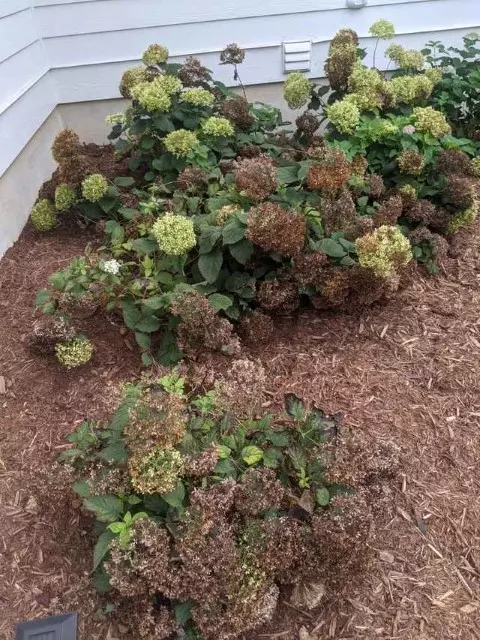
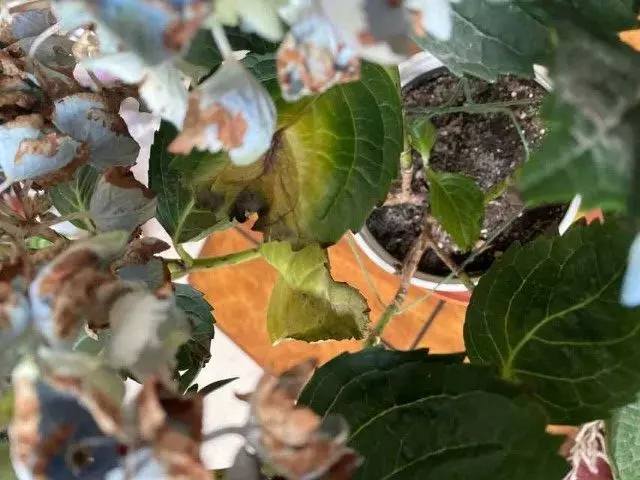
In the hottest season, daily watering will be necessary. Depending on rainfall, you can water 3 or 4 times a month in spring and autumn. In winter, you can reduce the watering frequency and, in case of occasional rains, providing more water will be practically unnecessary.
If you use automatic watering systems, choose a drip system rather than an overhead one. Hydrangeas are very prone to leaf disease if the leaves are wet, which is one of the most common Hydrangea Problems. Drip systems deliver water directly to the soil, thus keeping the leaves dry and providing a constant moisture supply. In addition, drip systems make better water use because there is much less evaporation. With less water, you get better results.
When our hydrangeas are newly planted, you should water them more frequently until they have rooted strongly. Water when the soil at a depth of 20 cm begins to dry out. You can use a moisture meter to check the moisture in the soil and measure the soil pH. This device recommended below will measure moisture and pH (no batteries needed)
- Kindly NOTE: This soil tester can not be applied to test pH value of any other liquid. If the soil is too dry the indicator will not move, and water it before testing.
- 3 METERS IN ONE: Soil moisture level, Soil pH value and Sunlight level could be tested easily according to your need by switching the function button of this soil meter.
- NO BATTERY NEEDED: Simply insert the meter into soil, wait few minutes, accurate test results will be displayed on the readout panel. No battery is needed.
Watering should be done by spreading the water evenly around the hydrangea but not soaking it.
To conserve moisture and improve your hydrangeas’ health, ensure the substrate contains organic matter, such as wood chips.
Hydrangeas need moist but well-drained soil. They are prone to root rot in clay soils or soils that do not drain sufficiently.
Hydrangea Problems: Why Hydrangea Won’t Bloom
Common Problems with Hydrangeas – Why Hydrangea Won’t Bloom – The leaves fall off and do not bloom. It lacks food, or the fertilizer is incorrect. Choose a fertilizer for hydrangeas. Additionally, make sure your hydrangeas are planted in the right place. Also, check watering issues. Hydrangeas need plenty of water, especially during the flowering and growing season.
All types of hydrangeas grow and bloom well if you place them in a location where they receive sufficient sunlight in the morning and shade in the afternoon. Hydrangeas especially appreciate these light conditions. It is important to consider the average temperature in your area. For example, if you live where the sun falls very strongly, and temperatures are high, you will probably need to limit the number of hours of sun exposure.
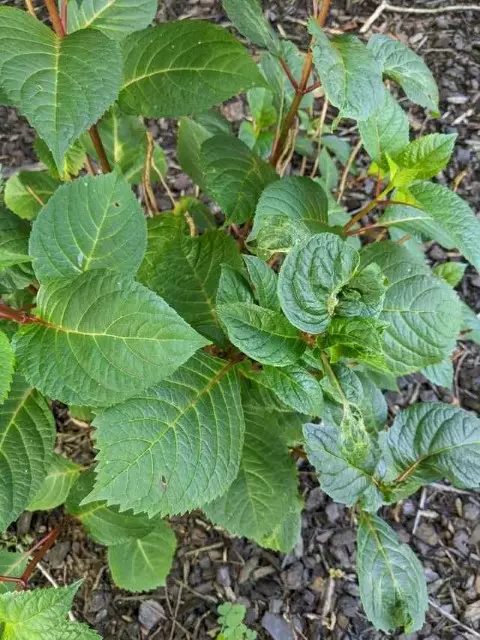
On the other hand, if you live in an area where the sun is not as aggressive, your hydrangeas may be able to live well even if they receive plenty of sun for most of the day.
Why Hydrangea Won’t Bloom – Avoid placing your hydrangeas in a very shady spot, such as under the shade of a tree. In low light conditions, hydrangeas can live, but you will find that they will not bloom or will bloom sparsely. You should also avoid windy areas, as this will cause the flowers to dry out quickly, and if the wind is too strong, it can damage them.
Why Hydrangea Won’t Bloom – One last tip about flowering problems. It may happen if the hydrangeas were pruned incorrectly, as in the picture below.
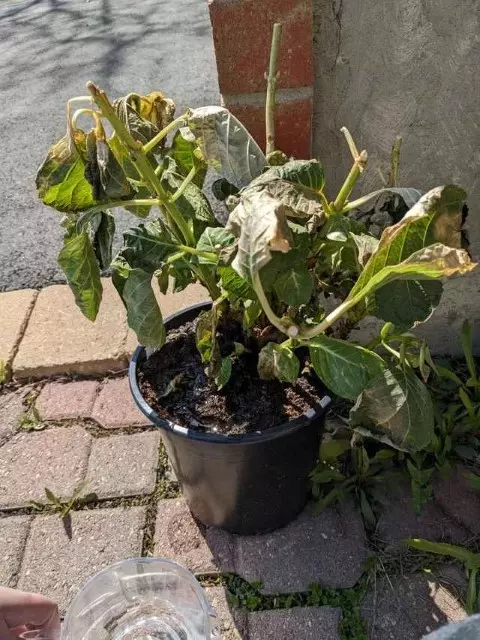
What is incorrect pruning? Meaning that it was not the right time to prune hydrangeas or the pruning was done on the wrong branches) it may be a cause of why the hydrangeas do not bloom even if we fertilize or encourage them in various ways to bloom. I believe in this article. You should find the information to learn about Pruning Endless Summer Hydrangeas and How to Prune Hydrangeas – Guide
How to Encourage Hydrangeas to Bloom
Common Problems with Hydrangeas – How to Encourage Hydrangeas to Bloom. One of the keys to encouraging hydrangeas to bloom and caring for hydrangeas is fertilizing. Hydrangeas, like most plants, grow best if they are properly fertilized.
In the flowering season, that is, in spring and summer, it will be necessary to fertilize every two weeks or so with a fertilizer suitable for plants that grow in acidic substrates.
You can find specific fertilizers for your hydrangeas in your store. You can choose a soluble or granular fertilizer, depending on your preference. I suggest using a liquid fertilizer, as the dosage is easier to control.
How to Fertilize Hydrangeas Properly – Here is a list of tips to Encourage Hydrangeas to Bloom
- Always follow the manufacturer’s instructions when caring for your plants, as overexposure to fertilizer can easily kill your plants.
- After summer, hydrangeas prepare to overwinter. During this dormant period, you should NOT use any fertilizers on your hydrangeas. Do not fertilize Hydrangeas during winter.
- On potted hydrangeas, you should apply less fertilizer than on hydrangeas grown in the ground.
- Over-fertilizing can be much more damaging than not fertilizing your hydrangeas.
- Too much fertilizer will burn your plants and dry out the roots.
- It is better to under-fertilize than to over-fertilize your hydrangeas.
- Do not apply fertilizer right on the trunk or stem of the plant.
- If you are growing hydrangeas, start the fertilizer with the lowest dose and observe how the plant behaves.
- If you see that the flowering is not very lush, it means that the amount of fertilizer is short. You can gently increase the dose. In this way, you can elaborate a calendar of suitable fertilizers for your plants.
- During flowering, it is advisable to fertilize the hydrangea every week with a special liquid fertilizer for acidophilic plants. You must add it to the irrigation water following the dosage indicated by the manufacturer. Please do not overdo it, or you could damage its roots. A granular fertilizer will also work.
- Commercial manure or compost can be applied annually around the hydrangea base. As with chemical fertilizers, avoid applying manure next to the trunk or stems from the soil.
- Worm humus provides mineral nutrients: macronutrients (NPK) and micronutrients (zinc, iron, copper, manganese, boron, etc.) and replaces the application of chemical fertilizers on crops.
- The fertilizer sticks for our hydrangeas are a very practical element with good results in growth and flowering, both for growing in pots and outdoors.
- Recycle the organic waste from your kitchen with this Compost Bucket. After a few days, homemade compost will form and you can use it in the garden for your plants.
Premature Browning of Hydrangea Flowers
Common Problems with Hydrangeas – Premature Browning of Hydrangea Flowers due to Excess fertilizer.
Excess fertilizer can cause this effect. How to Fix this Premature Browning of Hydrangea Flowers? We can remove dried flowers and leaves to help the plant. Then, consider changing pots and replacing the entire substrate with a new one. Of course, do not apply fertilizer for at least 3 to 4 weeks and water normally.
A widespread mistake is overwatering when we realize that we have over-applied fertilizer. Please don’t do this. It is impossible to “wash off” the excess fertilizer, and all we will do is rot the roots.
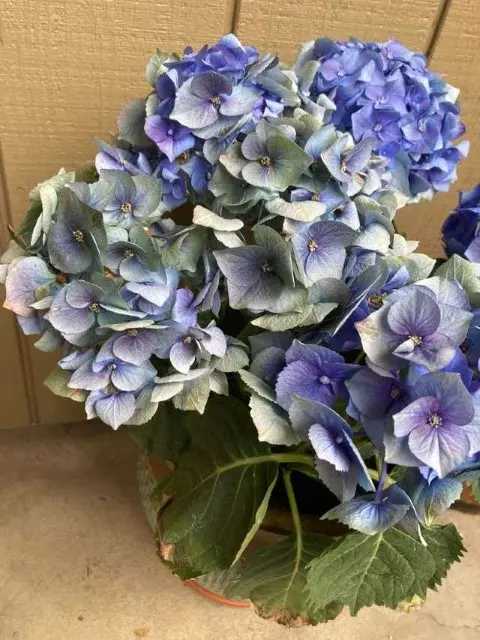
Why Do I Have Burned Hydrangea Leaves?
Common Problems with Hydrangeas – Why do I have burned Hydrangea leaves? Hydrangea leaves burn because of one main factor: exposure to the sun or frost damage (although less common, as you can see in the picture below).
The Hydrangea family comprises a multitude of Hydrangea varieties, most of which are shade or semi-shade. This means that both sun and high temperatures can negatively influence their development and explain some physiological alterations.
The burns on the leaves and flowers of Hydrangeas can be explained by exposure to full sun. For this reason, the solution is to change the plant’s location to a slightly shadier area or to accompany the Hydrangea with hedges, shrubs, or trees that provide the necessary shelter.
We should also look at watering or water from rain or dew. It is common to see small burns on the leaves of Hydrangeas caused by water droplets that become small magnifying glasses and work by enhancing the action of the sun on the plant.
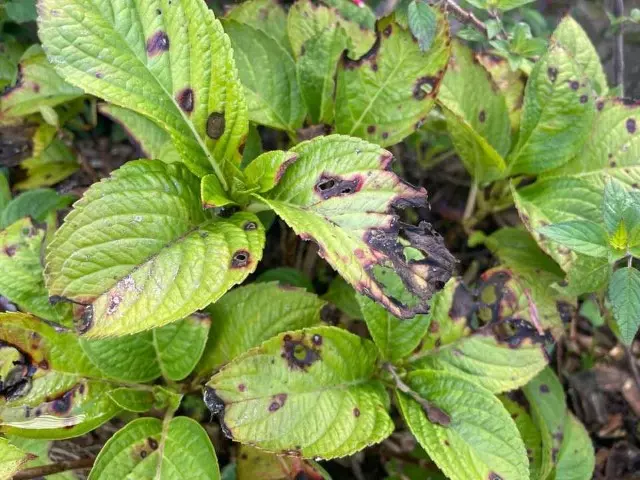
Common Hydrangea Problems – Yellow Leaves, Brown Spots
Common Problems with Hydrangeas – Yellow Leaves – When Hydrangea leaves turn yellow, we should watch the watering, the acidity of the soil, and the fertilizer we give to the plant in our garden or in its pots.
Chlorosis in hydrangeas causes yellowing of the leaves. Hydrangeas indicate that something is happening to them when they show their leaves changing from green to yellow. However, chlorosis is just one of the possible causes.
If you really want to understand How to Fix Yellow Hydrangea Leaves, I strongly suggest reading these two linked articles. How to Fix Yellow Hydrangea Leaves and Brown Spots Due to Nutrient Deficiencies and Fungus
Below are two pictures of hydrangea diseases with yellowing leaves for lack of nutrients and chlorosis.
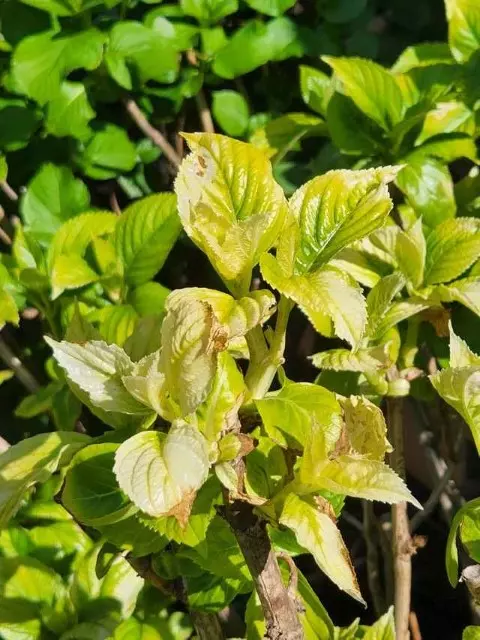
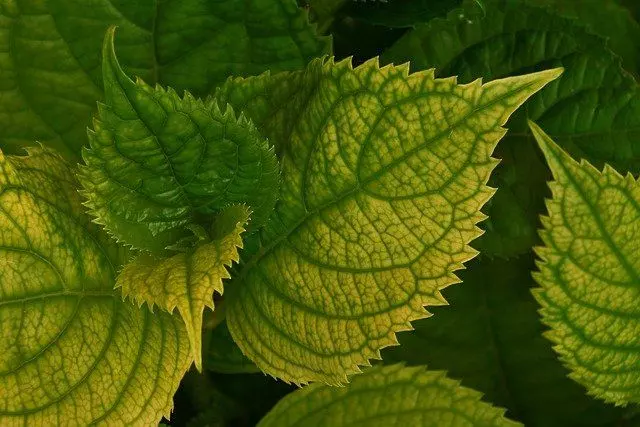
Pictures of Hydrangea Diseases Right: Hydrangea Yellow Leaves due to Iron Chlorosis – Yellow leaves and green nerves
Whenever we detect that the Hydrangea is not as it should be, it is a good habit to review and review the tips on How to care for Hydrangeas in the ground and potted Hydrangeas, to be more accurate in the diagnosis and fix the yellow leaves of hydrangeas. How to Care for Hydrangea – Complete Guide and How to Care for Potted Hydrangeas Outdoors
Repot Hydrangeas
Common Problems with Hydrangeas – Repot Hydrangeas – Hydrangeas have a lot of roots and require a lot of water, so a smaller pot will be uncomfortable when planning watering and caring for your plant.
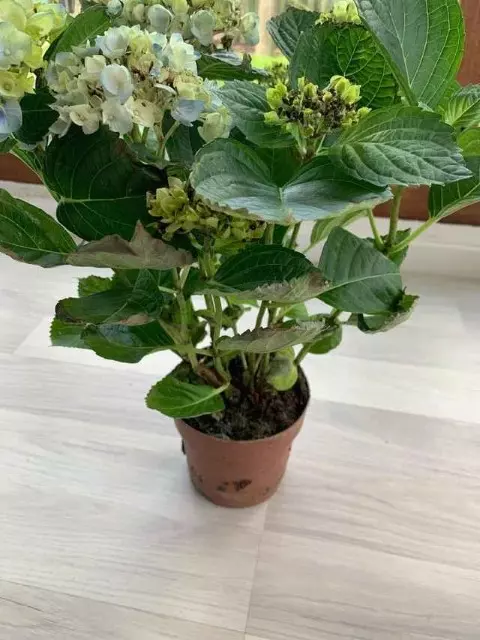
A common mistake with hydrangeas is that we don’t change the pot every year or at least every 2 years. We buy them and leave the poor plant in the pot for a few years until, suddenly, our hydrangea doesn’t give anymore. It literally dies because those roots make a tremendous effort to keep blooming.
So if you are reading this and your hydrangeas look like these pictures. Or if reading this made you realize that you haven’t changed the pot of your hydrangea either, get to work.
Choose a suitable size for repotting, and be sure you are in the right season to repot your hydrangeas. Recommended article for you How to Repot Hydrangeas – When and How
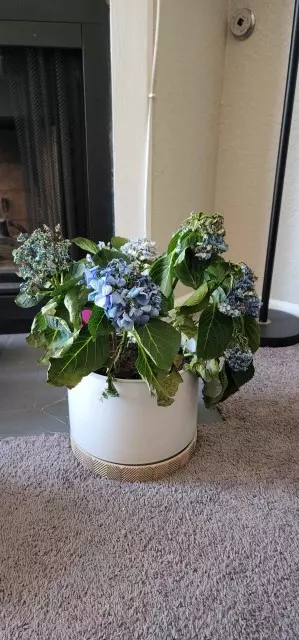
Common Problems with Hydrangeas – Blue Flowers Turn Pink
Common Problems with Hydrangeas – Blue Flowers Turn Pink – Change Color of Hydrangeas. This happens when you stop using products to blue the color for a while, or you are not preparing or diluting correctly.
Most hydrangeas are pink-flowered, although there are some species with white flowers. The quality of the soil influences the intensity of the color shades.
The blue flowers actually rose that, when the plant is watered with aluminum sulfate, change their color. In the florist’s shops, they sell a product to achieve this, it is called “hydrangea bluer”. The hydrangeas species with white flowers do not change color.
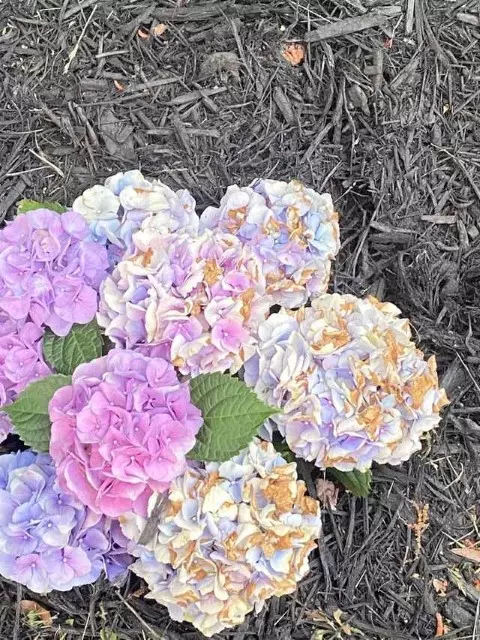
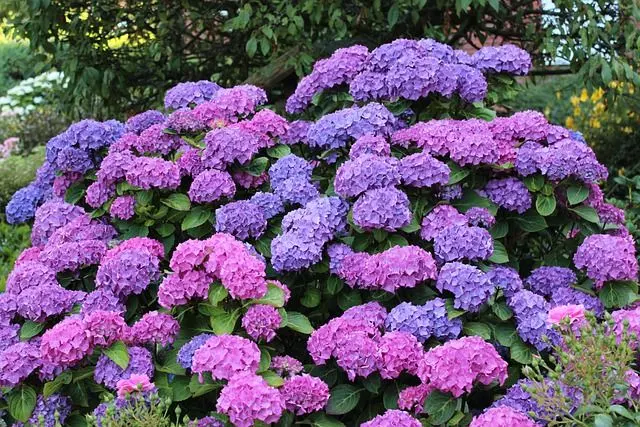
The degree of acidity or alkalinity of the soil is classified according to the pH. Thus, soils with low pH cause hydrangea to change color to blue tones, while soils with high pH cause hydrangea to change color to pink tones.
White hydrangeas do not undergo color changes as a result of pH alterations. However, pink or blue hydrangeas depend on the pH of the soil.
The main cause of color change in hydrangea flowers is aluminum. Depending on its presence or absence, the flower will change to one color or the other. To understand more about How to Change Colors of Hydrangea – Ultimate Guide, I recommend you to read this article.
Hydrangeas with Insects: Aphids, Mealybugs, or Green Flies
Lastly, another common Hydrangea Problem -Shoots with insects: aphids, mealybugs, or green flies. Wash the plant well and apply neem oil for plants or insecticide spikes.
Mealybugs and aphids feed on hydrangea nutrients and progress to weaken the hydrangea.
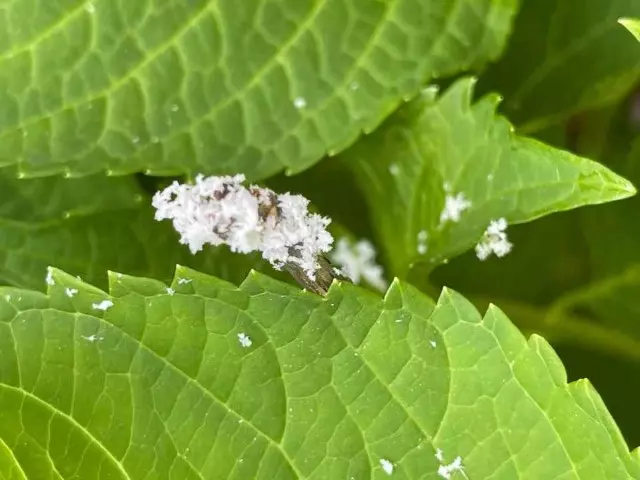
Some signs are yellow hydrangea leaves, and it is easy to confirm infection by looking closely at our hydrangeas. Eliminate them, and you will easily revive your hydrangeas.
- Broad Spectrum Fungicide Insecticide Miticide
- For indoor or outdoor use
- Treat Flowering Plants, Trees, Shrubs, Foliage, Vegitables, Fruits, Nuts, and all Landscapes
I hope you found this guide about the most common problems with hydrangeas useful and found the photos helpful in diagnosing and fixing the problem. Feel free to contact us with questions and comments about what you want to see in The Garden Style.


